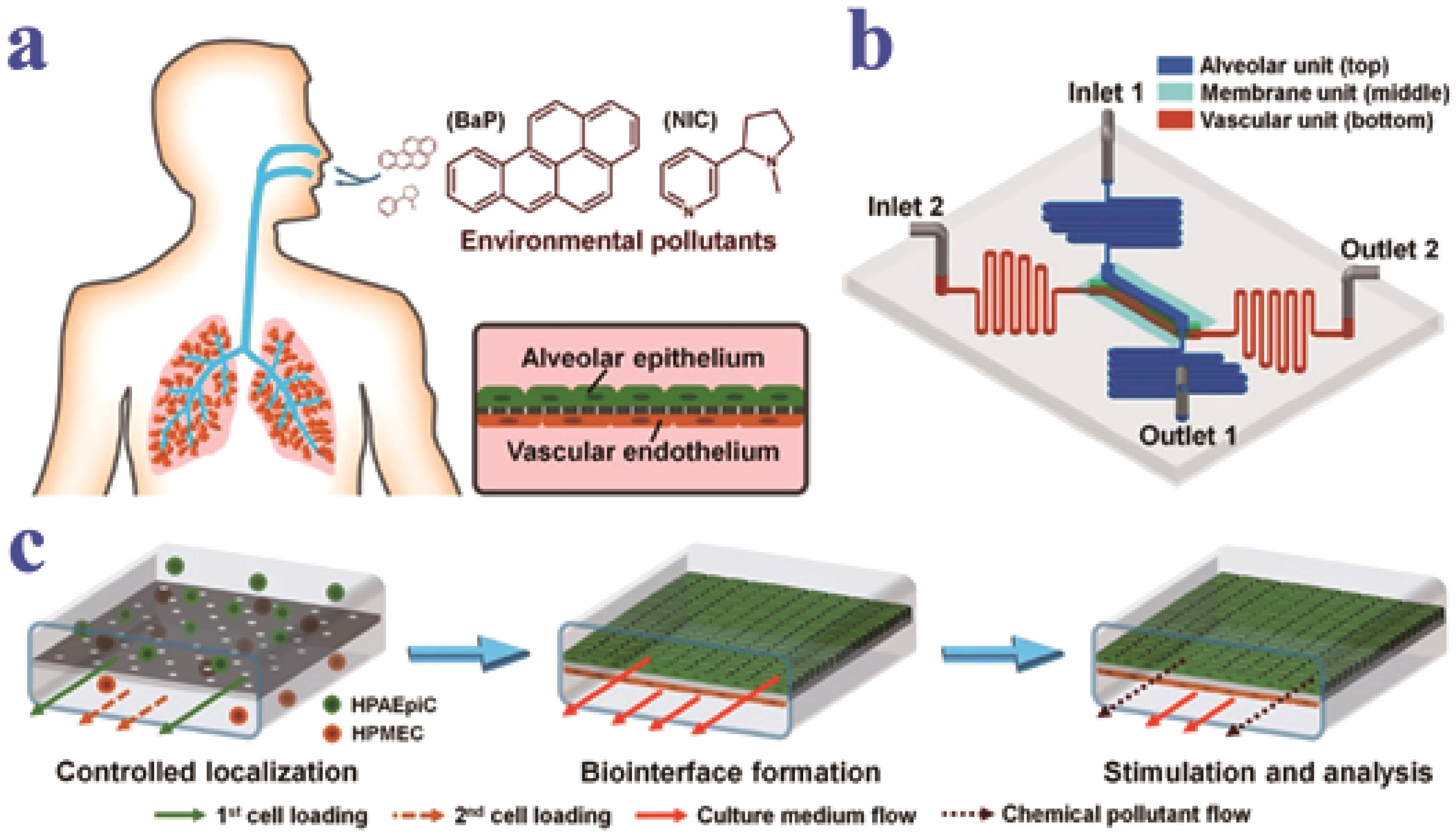
Chinese Journal of Applied Chemistry ›› 2022, Vol. 39 ›› Issue (1): 18-34.DOI: 10.19894/j.issn.1000-0518.210446
• Review • Previous Articles Next Articles
Research Progress on Bioinspired Organs⁃on⁃Chips
SUN Ling-Yu,GUO Jia-Hui,WANG Yu,XU Dong-Yu,ZHAO Yuan-Jin( )
)
- State Key Laboratory of Bioelectronics,School of Biological Science and Medical Engineering,Southeast University,Nanjing 210096,China
-
Received:2021-09-01Accepted:2021-10-08Published:2022-01-01Online:2022-01-10 -
Contact:Yuan-Jin ZHAO -
About author:yjzhao@seu.edu.cn
-
Supported by:the National Key Research and Development Program of China(2020YFA0908200);the National Natural Science Foundation of China(52073060);Shenzhen Fundamental Research Program(JCYJ20190813152616459)
CLC Number:
Cite this article
SUN Ling-Yu, GUO Jia-Hui, WANG Yu, XU Dong-Yu, ZHAO Yuan-Jin. Research Progress on Bioinspired Organs⁃on⁃Chips[J]. Chinese Journal of Applied Chemistry, 2022, 39(1): 18-34.
share this article
Add to citation manager EndNote|Ris|BibTeX
URL: http://yyhx.ciac.jl.cn/EN/10.19894/j.issn.1000-0518.210446

Fig.1 (a) Schematic diagram and the formation process of adhesive disc-like microparticles from microfluidics[17]. (b) Scheme and fabrication of helical microfibers from microfluidics with different flow rates[20]. (c) Bright field images of hierarchical photonic crystal films on different shapes of substrates via self-assembly at gas-liquid interface[23]. (d) Adhesive and self-reporting feature of structural color hydrogel patches replicated from self-assembled colloidal crystal templates[24]
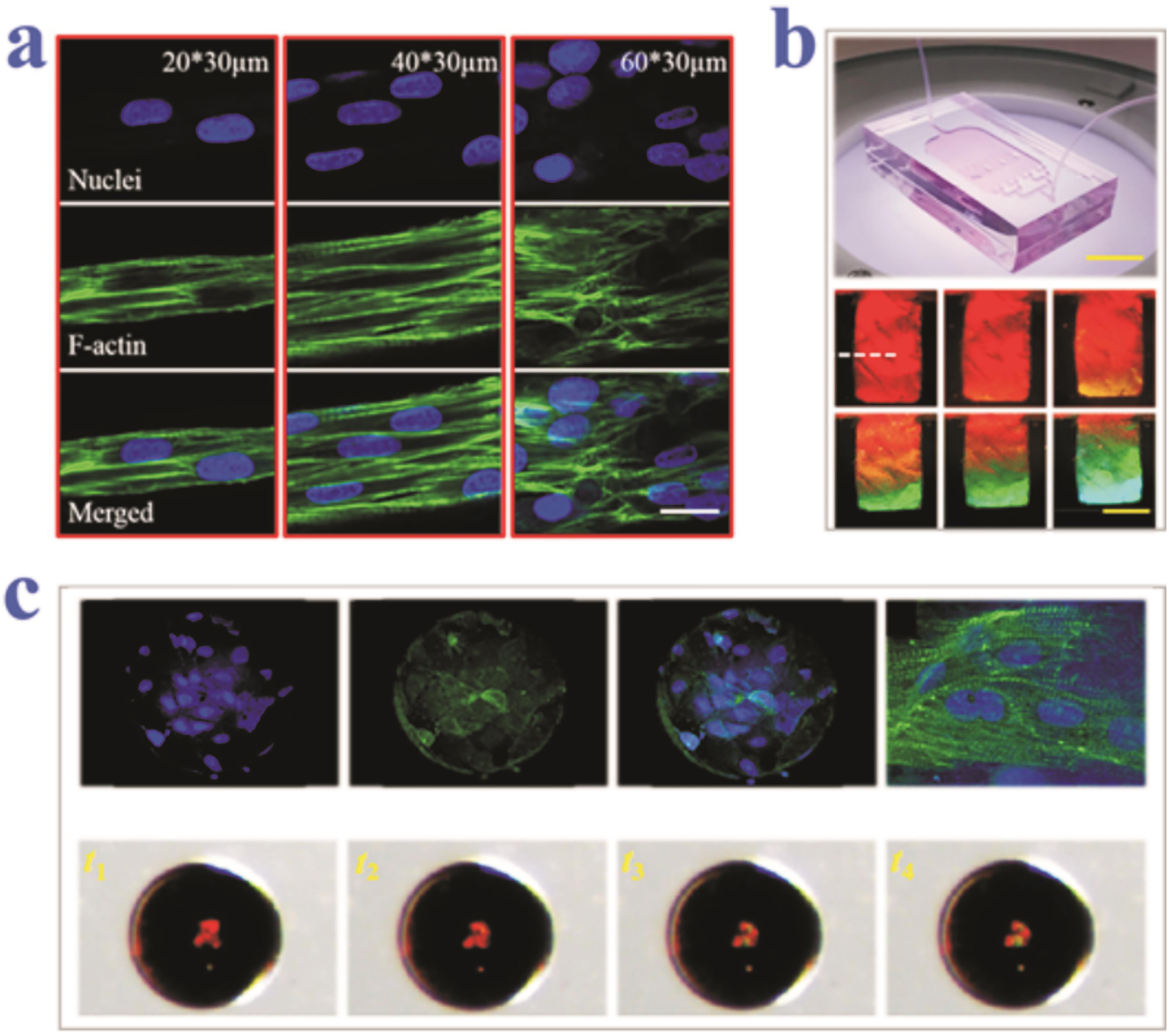
Fig.2 (a) Fluorescent images showing the alignment of cardiomyocytes on structural color hydrogels with different concave and convex side values[58]. (b) Inverse opal film-integrated heart-on-a-chip and the structural color variation during film deformation process driven by cardiomyocytes[60].. (c) Fluorescent images of cardiomyocytes cultured on an inverse opal microparticle and its structural color change under the actuation of cardiomyocytes[62]
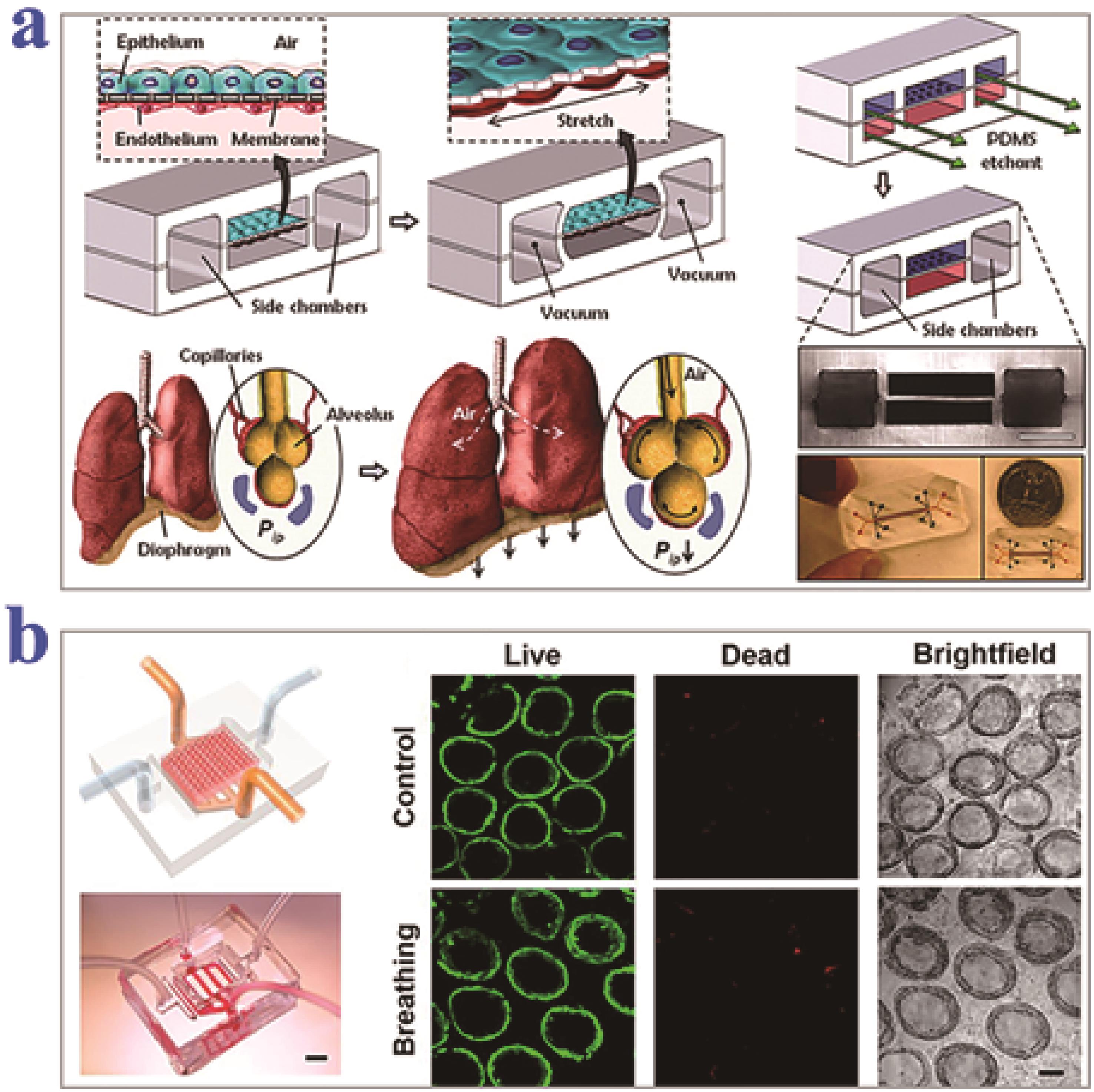
Fig.3 (a) Schematic diagram and optical image of a breathable human lung-on-a-chip[66]. (b) A lung-on-a-chip integrated with inverse opal-structured hydrogel scaffold, and the viability comparison between human alveolar epithelial cells that cultured in the chip without or with breathing[67]
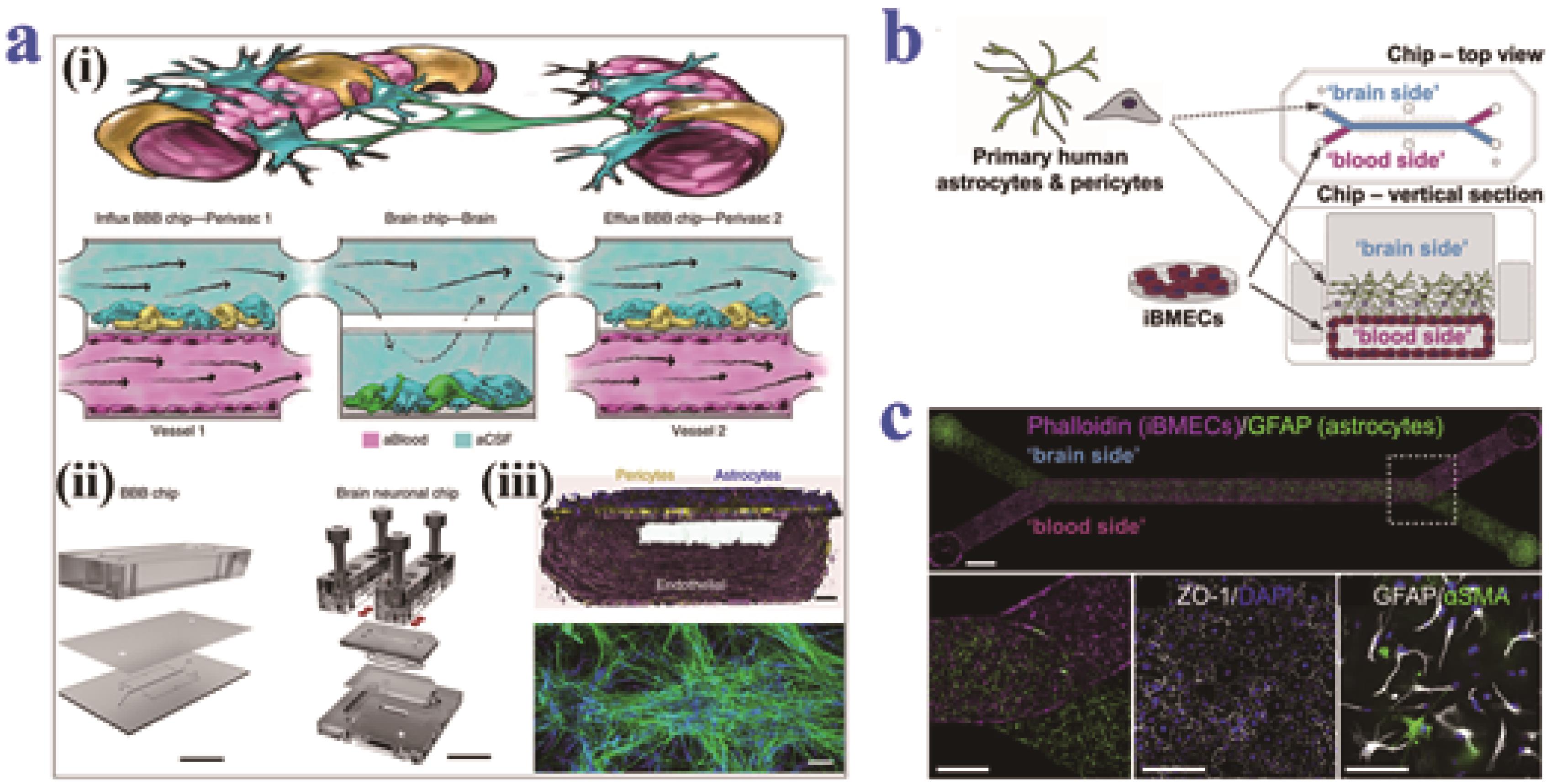
Fig.4 (a) Simplified scheme of neurovascular unit and BBB-brain parenchyma-BBB device (i), optical photograph showing the design of the desired brain chip (ii) and fluorescent 3D reconstruction of the brain tissue cultured in the chip (iii)[72]. (b - c) Construction of a human BBB chip using multiple cells derived from induced pluripotent stem cells[73]
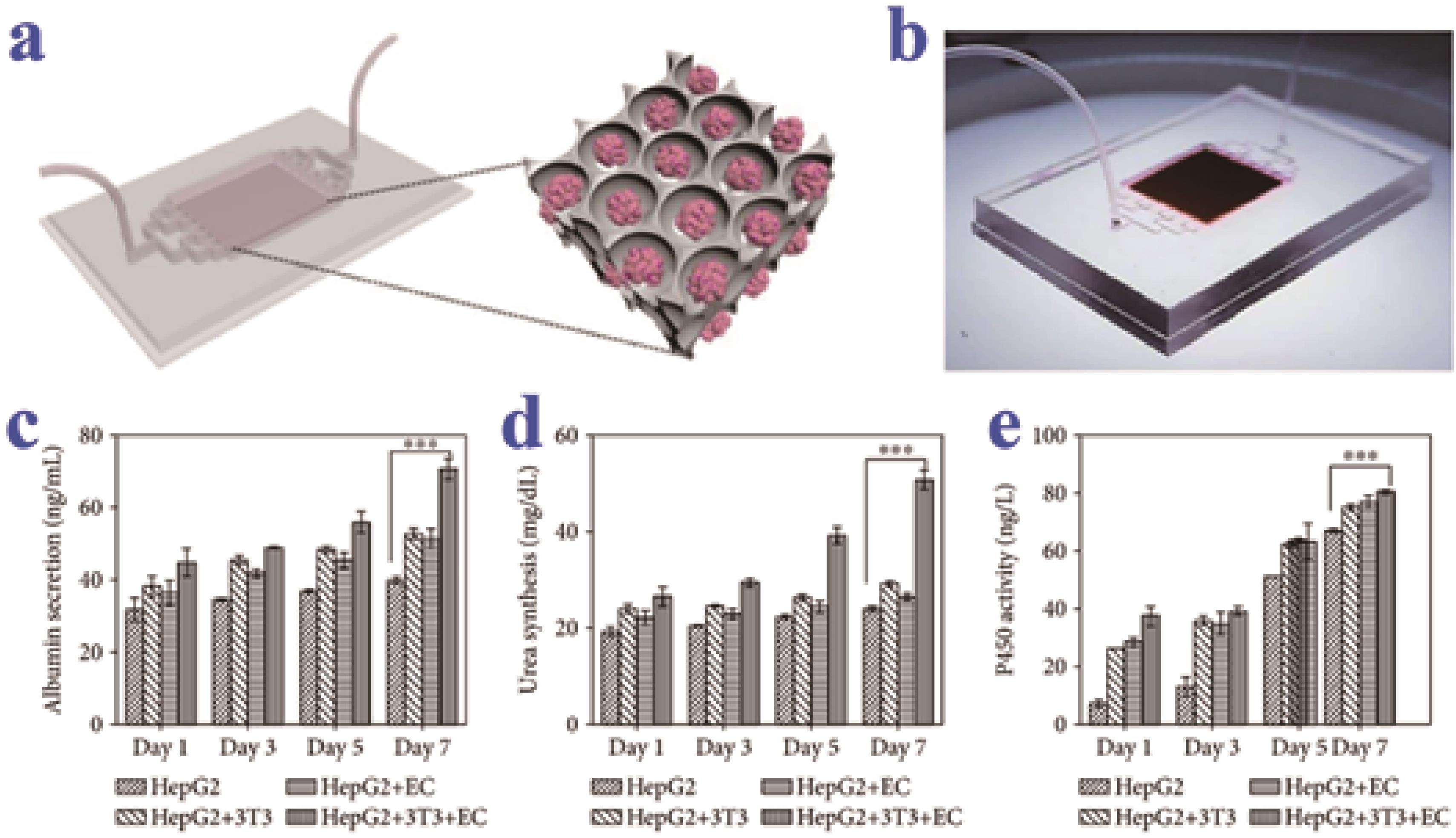
Fig.5 A liver-on-a-chip based on responsive scaffolds with responsive feature and its function evaluation[79]: (a) Schematic diagram of the liver-on-a-chip. (b) Optical image of the inverse opal scaffold-integrated liver-on-a-chip. (c - e) Data statistics showing the albumin secretion (c), urea synthesis (d) and cytochrome P450 expression level (e) in different groups, respectively
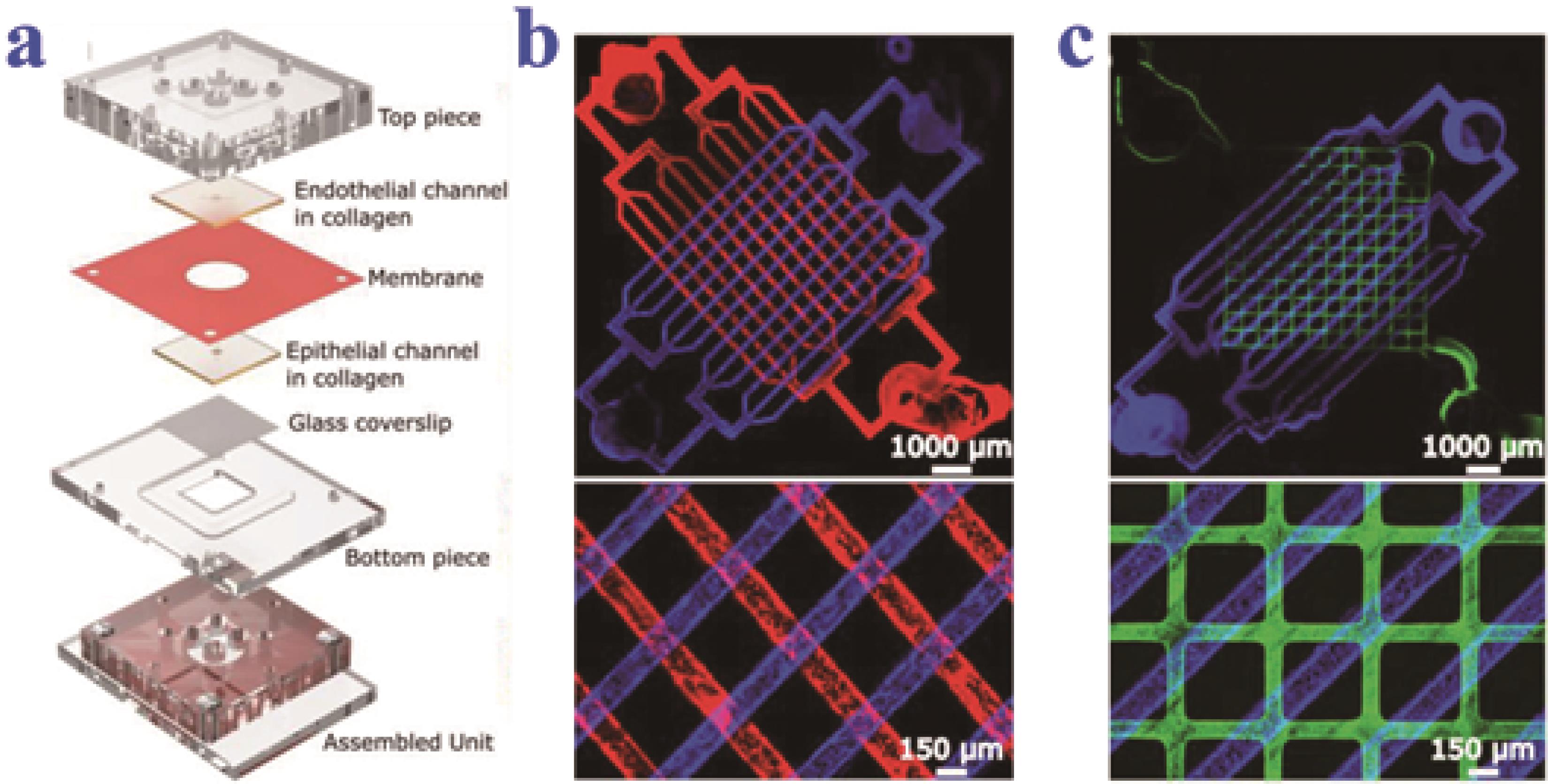
Fig.6 (a) Design of a renal vascular-tubular unit chip. (b, c) The chip was composed of a parallel-channel bottom layer and a parallel-channel (b) or a grid-channel (c) top layer[85]
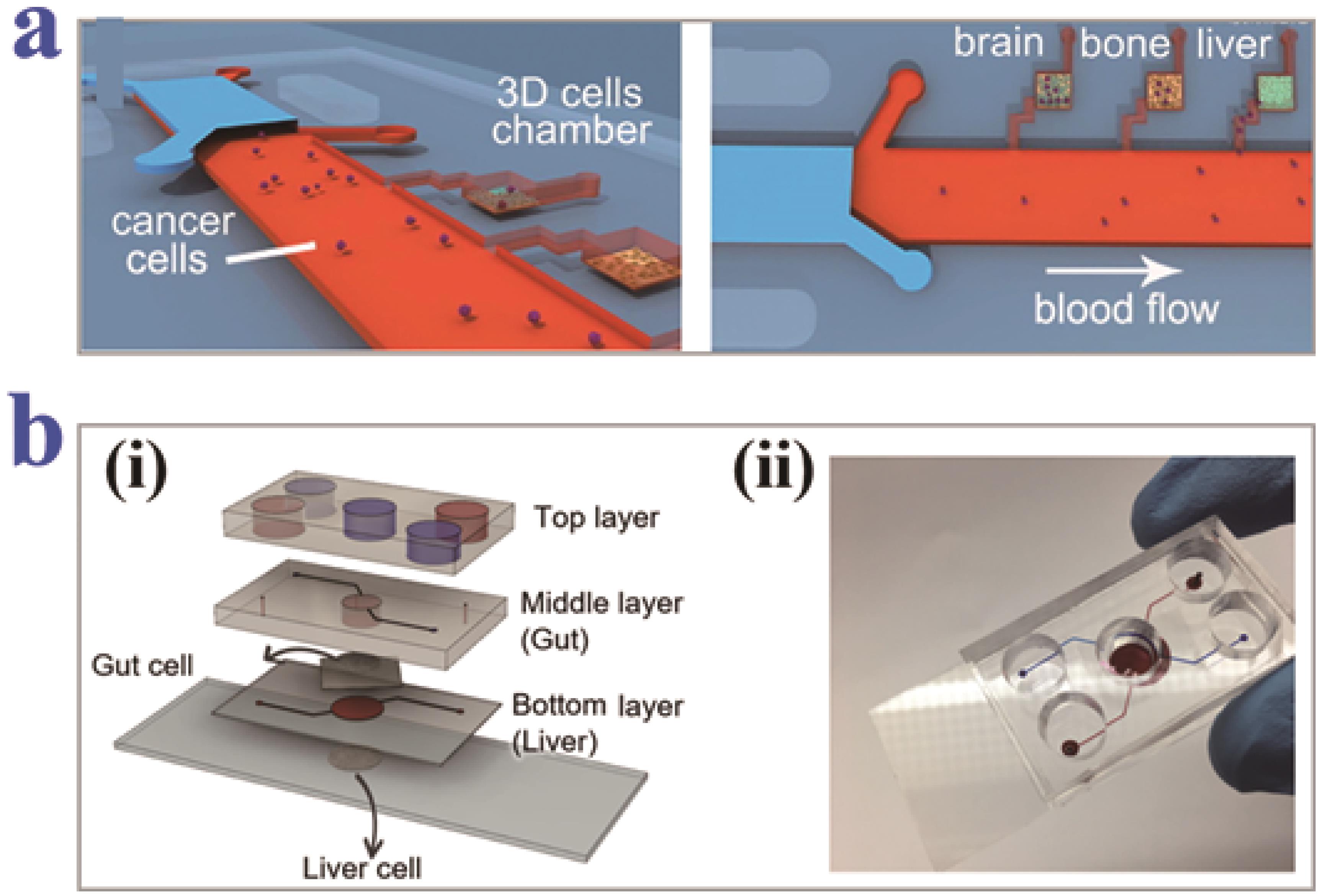
Fig.7 (a) Channel design of a multi-organ chip for simulating lung cancer metastasis to the brain, bone and liver[92]. (b) The chip fabrication (i) and optical photograph (ii) of a gut-liver-on-a-chip[94]
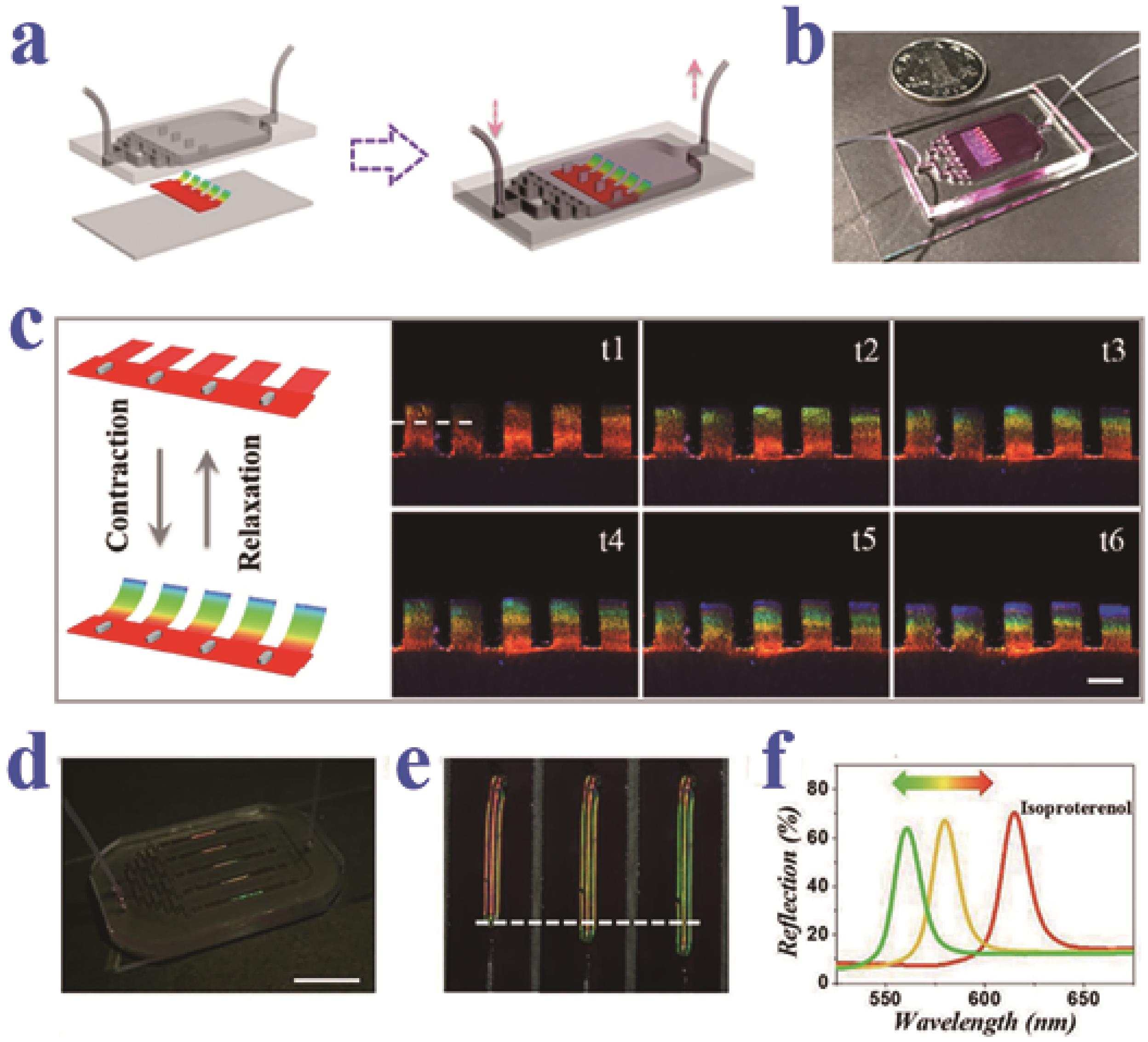
Fig.9 (a–c) Heart-on-a-chip based on micropatterned structural color hydrogel film and its application for drug evaluation[58]. (d–f) Structural color microfiber-integrated multichannel heart-on-a-chip for gradient drug testing[63]
| 1 | WEGST U G K, BAI H, SAIZ E, et al. Bioinspired structural materials[J]. Nat Mater, 2015, 14(1): 23-36. |
| 2 | KONG T, LUO G, ZHAO Y, et al. Bioinspired superwettability micro/nanoarchitectures: fabrications and applications[J]. Adv Funct Mater, 2019, 29(11): 1808012. |
| 3 | LI R, FAN X, LIU Z, et al. Smart bioinspired nanochannels and their applications in energy-conversion systems[J]. Adv Mater, 2017, 29(45): 1702983. |
| 4 | KIM T, SEE C W, LI X C, et al. Orthopedic implants and devices for bone fractures and defects: past, present and perspective[J]. Eng Regener, 2020, 1: 6-18. |
| 5 | 张青, 戴起勋, 赵玉涛, 等. 仿生材料设计与制备的研究进展[J]. 江苏大学学报(自然科学版), 2003, 24(6): 55-60. |
| ZHANG Q, DAI Q X, ZHAO Y T, et al. Progress in design and fabrication of biomimetic material[J]. J Jiangsu Univ (Nat Sci Ed), 2003, 24(6): 55-60. | |
| 6 | MAZZOLAI B, LASCHI C. A vision for future bioinspired and biohybrid robots[J]. Sci Robot, 2020, 5(38): eaba6893. |
| 7 | SABU C, REJO C, KOTTA S, et al. Bioinspired and biomimetic systems for advanced drug and gene delivery[J]. J Control Release, 2018, 287: 142-155. |
| 8 | CAPLIN J D, GRANADOS N G, JAMES M R, et al. Microfluidic organ-on-a-chip technology for advancement of drug development and toxicology[J]. Adv Healthcare Mater, 2015, 4(10): 1426-1450. |
| 9 | CHEN X, ZHANG Y S, ZHANG X, et al. Organ-on-a-chip platforms for accelerating the evaluation of nanomedicine[J]. Bioact Mater, 2021, 6(4): 1012-1027. |
| 10 | ZHANG B, KOROLJ A, LAI B F L, et al. Advances in organ-on-a-chip engineering[J]. Nat Rev Mater, 2018, 3(8): 257-278. |
| 11 | SHANG L, CHENG Y, ZHAO Y. Emerging droplet microfluidics[J]. Chem Rev, 2017, 117(12): 7964-8040. |
| 12 | CHENG Y, ZHENG F, LU J, et al. Bioinspired multicompartmental microfibers from microfluidics[J]. Adv Mater, 2014, 26(30): 5184-5190. |
| 13 | CAI L, WANG H, YU Y, et al. Stomatocyte structural color-barcode micromotors for multiplex assays[J]. Natl Sci Rev, 2020, 7(3): 644-651. |
| 14 | GUO J, YU Y, ZHANG D, et al. Morphological hydrogel microfibers with MXene encapsulation for electronic skin[J]. Research, 2021, 2021: 7065907. |
| 15 | WANG J, LE-THE H, WANG Z, et al. Microfluidics assisted fabrication of three-tier hierarchical microparticles for constructing bioinspired surfaces[J]. ACS Nano, 2019, 13(3): 3638-3648. |
| 16 | SUN L, BIAN F, WANG Y, et al. Bio-inspired programmable wettability arrays for droplets manipulation[J]. Proc Natl Acad Sci USA, 2020, 117(9), 4527-4532. |
| 17 | CAI L, CHEN G, WANG Y, et al. Boston ivy-inspired disc-like adhesive microparticles for drug delivery[J]. Research, 2021, 2021: 9895674. |
| 18 | CHENG Y, ZHU C, XIE Z, et al. Anisotropic colloidal crystal particles from microfluidics[J]. J Colloid Interface Sci, 2014, 421: 64-70. |
| 19 | SHANG L, WANG Y, YU Y, et al. Bio-inspired stimuli-responsive graphene oxide fibers from microfluidics[J]. J Mater Chem A, 2017, 5(29): 15026-15030. |
| 20 | YU Y, FU F, SHANG L, et al. Bioinspired helical microfibers from microfluidics[J]. Adv Mater, 2017, 29(18): 1605765. |
| 21 | GOERLITZER E S A, KLUPP TAYLOR R N, VOGEL N. Bioinspired photonic pigments from colloidal self-assembly[J]. Adv Mater, 2018, 30(28): 1706654. |
| 22 | WU Z, LIN X, SI T, et al. Recent progress on bioinspired self-propelled micro/nanomotors via controlled molecular self-assembly[J]. Small, 2016, 12(23): 3080-3093. |
| 23 | ZHANG L, SUN L, ZHANG Z, et al. Bioinspired superhydrophobic surface by hierarchically colloidal assembling of microparticles and colloidal nanoparticles[J]. Chem Eng J, 2020, 394: 125008. |
| 24 | WANG Y, SHANG L, CHEN G, et al. Bioinspired structural color patch with anisotropic surface adhesion[J]. Sci Adv, 2020, 6(4): eaax8258. |
| 25 | HE C, YE T, TENG W, et al. Bioinspired shear-flow-driven layer-by-layer in situ self-assembly[J]. ACS Nano, 2019, 13(2): 1910-1922. |
| 26 | CONTE M P, LAU K H A, ULIJIN R V. Biocatalytic self-assembly using reversible and irreversible enzyme immobilization[J]. ACS Appl Mater Interfaces, 2017, 9(4): 3266-3271. |
| 27 | LI T, CHANG J, ZHU Y, et al. 3D printing of bioinspired biomaterials for tissue regeneration[J]. Adv Healthcare Mater, 2020, 9(23): 2000208. |
| 28 | WANG D, CHEN D, CHEN Z. Recent progress in 3D printing of bioinspired structures[J]. Front Mater, 2020, 7: 286. |
| 29 | YAN C, JIANG P, JIA X, et al. 3D printing of bioinspired textured surfaces with superamphiphobicity[J]. Nanoscale, 2020, 12(5): 2924-2938. |
| 30 | LIU X, GU H, WANG M, et al. 3D printing of bioinspired liquid superrepellent structures[J]. Adv Mater, 2018,30(22): 1800103. |
| 31 | VANAEI S, PARIZI M S, SALEMIZADEHPARIZI F, et al. An overview on materials and techniques in 3D bioprinting toward biomedical application[J]. Eng Regener, 2021, 2: 1-18. |
| 32 | LI X, SHAN W, YANG Y, et al. Limpet tooth-inspired painless microneedles fabricated by magnetic field-assisted 3D printing[J]. Adv Funct Mater, 2021, 31(5): 2003725. |
| 33 | WANG H, HUANG Z, LI J, et al. Design of 3D printed bioinspired nacre-like structured materials with significantly enhanced thermal conductivity[J]. Appl Phys Lett, 2021, 118: 131903. |
| 34 | LIU L, LIU S, SCHELP M, et al. Rapid 3D printing of bioinspired hybrid structures for high-efficiency fog collection and water transportation[J]. ACS Appl Mater Interfaces 2021, 13(24): 29122-29129. |
| 35 | LEE H, HAN W, KIM H, et al. Development of liver decellularized extracellular matrix bioink for three-dimensional cell printing-based liver tissue engineering[J]. Biomacromolecules, 2017, 18(4): 1229-1237. |
| 36 | KIM B S, KWON Y W, KONG J S, et al. 3D cell printing of in vitro stabilized skin model and in vivo pre-vascularized skin patch using tissue-specific extracellular matrix bioink: a step towards advanced skin tissue engineering[J]. Biomaterials, 2018, 168: 38- 53. |
| 37 | JANG J, PARK J Y, GAO G, et al. Biomaterials-based 3D cell printing for next-generation therapeutics and diagnostics[J]. Biomaterials, 2018, 156: 88-106. |
| 38 | KIM J, KONG J S, HAN W, et al. 3D cell printing of tissue/organ-mimicking constructs for therapeutic and drug testing applications[J]. Int J Mol Sci, 2020, 21(20): 7757. |
| 39 | KUANG X, ROACH D J, WU J, et al. Advances in 4D printing: materials and applications[J]. Adv Funct Mater, 2019, 29(2): 1805290. |
| 40 | VELASCO-HOGAN A, XU J, MEYERS M A. Additive manufacturing as a method to design and optimize bioinspired structures[J]. Adv Mater, 2018, 30(52): 1800940. |
| 41 | LEE A Y, AN J, CHUA C K. Two-way 4D printing: a review on the reversibility of 3D-printed shape memory materials[J]. Engineering, 2017, 3(5): 663-674. |
| 42 | ZHANG B, ZHANG W, ZHANG Z, et al. Self-healing four-dimensional printing with an ultraviolet curable double-network shape memory polymer system[J] ACS Appl Mater Interfaces, 2019, 11(10): 10328-10336. |
| 43 | JU J, XIAO K, YAO X, et al. Bioinspired conical copper wire with gradient wettability for continuous and efficient fog collection[J]. Adv Mater, 2013, 25(41): 5937-5942. |
| 44 | MA Z C, LI C H, HU X Y, et al. Laser fabrication of bioinspired graphene surfaces with superwettability[J]. Front Chem, 2020, 8: 525. |
| 45 | COBURN J M, GIBSON M, MONAGLE S, et al. Bioinspired nanofibers support chondrogenesis for articular cartilage repair[J]. Proc Natl Acad Sci USA, 2012, 109(25): 10012-10017. |
| 46 | SHAO J Y, CHEN X L, LI X M, et al. Nanoimprint lithography for the manufacturing of flexible electronics[J]. Sci China Technol Sci, 2019, 62(2): 175-198. |
| 47 | SUN J, BHUSHAN B. Nanomanufacturing of bioinspired surfaces[J]. Tribol Int, 2019, 129: 67-74. |
| 48 | MA C, PENG Y, LI H, et al. Organ-on-a-chip: a new paradigm for drug development[J]. Trends Pharmacol Sci, 2021, 42(2), 119-133. |
| 49 | 陈超瑜, 马妍, 方群. 微流控器官芯片的研究进展[J]. 分析化学, 2019, 47(11): 1711-1720. |
| CHEN C Y, MA Y, FANG Q. Advances in microfluidic organ-on-a-chip systems[J]. Chinese J Anal Chem, 2019, 47(11): 1711- 1720. | |
| 50 | KITSARA M, KONTZIAMPASIS D, AGBULUT O, et al. Heart on a chip: micro-nanofabrication and microfluidics steering the future of cardiac tissue engineering[J]. Microelectron Eng, 2019, 203: 44-62. |
| 51 | 陈颖, 付炜. 心脏芯片研究进展[J]. 组织工程与重建外科, 2021, 17(1): 66-69. |
| CHEN Y, FU W. Research progress of microfluidic heart on a chip[J]. J Tissue Eng Reconstr Surg, 2021, 17(1): 66-69. | |
| 52 | ZHANG X, WANG T, WANG P, et al. High-throughput assessment of drug cardiac safety using a high-speed impedance detection technology-based heart-on-a-chip[J]. Micromachines, 2016, 7(7): 122. |
| 53 | AGARWAL A, GOSS J A, CHO A, et al. Microfluidic heart on a chip for higher throughput pharmacological studies[J]. Lab Chip, 2013, 13(18): 3599-3608. |
| 54 | REN L, ZHOU X, NASIRI R, et al. Combined effects of electric stimulation and microgrooves in cardiac tissue-on-a-chip for drug screening[J]. Small Methods, 2020, 4(10): 2000438. |
| 55 | SHANG Y, CHEN Z, ZHANG Z, et al. Heart-on-chips screening based on photonic crystals[J]. Bio-des Manuf, 2020, 3(3): 266-280. |
| 56 | CHEN Z, FU F, YU Y, et al. Cardiomyocytes-actuated morpho butterfly wings[J]. Adv Mater, 2019, 31(8): 1805431. |
| 57 | LI L, CHEN Z, SHAO C, et al. Graphene hybrid anisotropic structural color film for cardiomyocytes' monitoring[J]. Adv Funct Mater, 2020, 30(3): 1906353. |
| 58 | FU F, SHANG L, CHEN Z, et al. Bioinspired living structural color hydrogels[J]. Sci Robot ,2018, 3(16): eaar8580. |
| 59 | GONG Y, CHEN Z, YANG L, et al. Intrinsic color sensing system allows for real-time observable functional changes on human induced pluripotent stem cell-derived cardiomyocytes[J]. ACS Nano, 2020, 14(7): 8232-8246. |
| 60 | SHANG Y, CHEN Z, FU F, et al. Cardiomyocyte-driven structural color actuation in anisotropic inverse opals[J]. ACS Nano, 2018, 13(1): 796-802. |
| 61 | SUN L, CHEN Z, BIAN F, et al. Bioinspired soft robotic caterpillar with cardiomyocyte drivers[J]. Adv Funct Mater, 2020, 30(6): 1907820. |
| 62 | WANG H, LIU Y, CHEN Z, et al. Anisotropic structural color particles from colloidal phase separation[J]. Sci Adv, 2020, 6(2): eaay1438. |
| 63 | CHEN Z, YU Y, GUO J, et al. Heterogeneous structural color microfibers for cardiomyocytes tug-of-war[J]. Adv Funct Mater, 2021, 31(9): 2007527. |
| 64 | SUN L, YU Y, CHEN Z, et al. Biohybrid robotics with living cell actuation[J]. Chem Soc Rev, 2020, 49(12): 4043-4069. |
| 65 | HUH D. A human breathing lung-on-a-chip[J]. Ann Am Thorac Soc, 2015, 12(Suppl 1): S42-S44. |
| 66 | HUH D, MATTHEWS B D, MAMMOTO A, et al. Reconstituting organ-level lung functions on a chip[J]. Science, 2010, 328(5986): 1662-1668. |
| 67 | HUANG D, LIU T, LIAO J, et al. Reversed-engineered human alveolar lung-on-a-chip model[J]. Proc Natl Acad Sci USA, 2021, 118(19): e2016146118. |
| 68 | STAICU C E, JIPA F, AXENTE E, et al. Lab-on-a-chip platforms as tools for drug screening in neuropathologies associated with blood-brain barrier alterations[J]. Biomolecules, 2021, 11(6): 916. |
| 69 | BANG S, JEONG S, CHOI N, et al. Brain-on-a-chip: a history of development and future perspective[J]. Biomicrofluidics, 2019, 13(5): 051301. |
| 70 | PARK T E, MUSTAFAOGLU N, HERLAND A, et al. Hypoxia-enhanced blood-brain barrier chip recapitulates human barrier function and shuttling of drugs and antibodies[J]. Nat Commun, 2019, 10(1): 1-12. |
| 71 | KIM J A, KIM H N, IM S K, et al. Collagen-based brain microvasculature model in vitro using three-dimensional printed template[J]. Biomicrofluidics, 2015, 9(2): 024115. |
| 72 | MAOZ B M, HERLAND A, FITZGERALD E A, et al. A linked organ-on-chip model of the human neurovascular unit reveals the metabolic coupling of endothelial and neuronal cells[J]. Nat Biotechnol, 2018, 36(9): 865-874. |
| 73 | VATINE G D, BARRILE R, WORKMAN M J, et al. Human iPSC-derived blood-brain barrier chips enable disease modeling and personalized medicine applications[J]. Cell Stem Cell, 2019, 24(6): 995-1005. |
| 74 | YI H G, JEONG Y H, KIM Y, et al. A bioprinted human-glioblastoma-on-a-chip for the identification of patient-specific responses to chemoradiotherapy[J]. Nat Biomed Eng, 2019, 3(7): 509-519. |
| 75 | MORADI E, JALILI-FIROOZINEZHAD S, SOLATI-HASHJIN M. Microfluidic organ-on-a-chip models of human liver tissue[J]. Acta Biomater, 2020, 116: 67-83. |
| 76 | DENG J, WEI W, CHEN Z, et al. Engineered liver-on-a-chip platform to mimic liver functions and its biomedical applications: a review[J]. Micromachines, 2019, 10(10): 676. |
| 77 | LEE H, CHAE S, KIM J Y, et al. Cell-printed 3D liver-on-a-chip possessing a liver microenvironment and biliary system[J]. Biofabrication, 2019, 11(2): 025001. |
| 78 | ZHANG Y, YANG N, XIE L, et al. A new 3D cultured liver chip and real-time monitoring system based on microfluidic technology[J]. Micromachines, 2020,11(12): 1118. |
| 79 | SHAO C, LIU Y, CHI J, et al. Responsive inverse opal graphene hydrogel scaffolds with biomimetic enrichment capability for cell culture[J]. Research, 2019, 2019: 9783793. |
| 80 | YA S, DING W, LI S, et al. On-chip construction of liver lobules with self-assembled perfusable hepatic sinusoid networks[J]. ACS Appl Mater Interfaces, 2021, 13(28): 32640-32652. |
| 81 | WANG Y, WANG H, DENG P, et al. Modeling human nonalcoholic fatty liver disease (NAFLD) with an organoids-on-a-chip system[J]. ACS Biomater Sci Eng, 2020,6(10): 5734-5743. |
| 82 | LEE J, KIM K, KIM S. Kidney on chips[J]. Method Cell Biol, 2018, 146: 85-104. |
| 83 | KIM S, TAKAYAMA S. Organ-on-a-chip and the kidney[J]. Kidney Res Clin Pract, 2015, 34(3): 165-169. |
| 84 | CHEN H, BIAN F, SUN L, et al. Hierarchically molecular imprinted porous particles for biomimetic kidney cleaning[J]. Adv Mater, 2020, 32(52): 2005394. |
| 85 | RAYNER S G, PHONG K T, XUE J, et al. Reconstructing the human renal vascular-tubular unit in vitro[J]. Adv Healthcare Mater, 2018, 7(23): 1801120. |
| 86 | MUSAH S, MAMMOTO A, FERRANTE T C, et al. Mature induced-pluripotent-stem-cell-derived human podocytes reconstitute kidney glomerular-capillary-wall function on a chip[J]. Nat Biomed Eng, 2017, 1(5): 1-12. |
| 87 | MUSAH S, DIMITRAKAKIS N, CAMACHO D M, et al. Directed differentiation of human induced pluripotent stem cells into mature kidney podocytes and establishment of a glomerulus chip[J]. Nat Protoc, 2018, 13(7): 1662-1685. |
| 88 | GIJZEN L, YENGEJ F A Y, SCHUTGENS F, et al. Culture and analysis of kidney tubuloids and perfused tubuloid cells-on-a-chip[J]. Nat Protoc, 2021, 16(4): 2023-2050. |
| 89 | WANG J, WANG C, XU N, et al. A virus-induced kidney disease model based on organ-on-a-chip: pathogenesis exploration of virus-related renal dysfunctions[J]. Biomaterials, 2019, 219: 119367. |
| 90 | BAUER S, HULDT C W, KANEBRATT K P, et al. Functional coupling of human pancreatic islets and liver spheroids on-a-chip: towards a novel human ex vivo type 2 diabetes model[J]. Sci Rep, 2017, 7(1): 1-11. |
| 91 | MASCHMEYER I, HASENBERG T, JAENICKE A, et al. Chip-based human liver-intestine and liver-skin co-cultures-a first step toward systemic repeated dose substance testing in vitro[J]. Eur J Pharm Biopharm, 2015, 95: 77-87. |
| 92 | XU Z, LI E, GUO Z, et al. Design and construction of a multi-organ microfluidic chip mimicking the in vivo microenvironment of lung cancer metastasis[J]. ACS Appl Mater Interfaces, 2016, 8(39): 25840-25847. |
| 93 | LIU W, SONG J, DU X, et al. AKR1B10 (Aldo-keto reductase family 1 B10) promotes brain metastasis of lung cancer cells in a multi-organ microfluidic chip model[J]. Acta Biomater, 2019, 91: 195-208. |
| 94 | JEON J, LEE S H, KIM D, et al. In vitro hepatic steatosis model based on gut-liver-on-a-chip[J]. Biotechnol Prog, 2021, 37(3): e3121. |
| 95 | MILLER P G, SHULER M L. Design and demonstration of a pumpless 14 compartment microphysiological system[J]. Biotechnol Bioeng, 2016, 113(10): 2213-2227. |
| 96 | RAMME A P, KOENIG L, HASENBERG T, et al. Autologous induced pluripotent stem cell-derived four-organ-chip[J]. Future Sci OA, 2019, 5(8): FSO413. |
| 97 | YANG S, CHEN Z, CHENG Y, et al. Environmental toxicology wars: organ-on-a-chip for assessing the toxicity of environmental pollutants[J]. Environ Pollut, 2020, 268: 115861. |
| 98 | CHO S, YOON J Y. Organ-on-a-chip for assessing environmental toxicants[J]. Curr Opin Biotech, 2017, 45: 34-42. |
| 99 | BHATIA S N, INGBER D E. Microfluidic organs-on-chips[J]. Nat Biotechnol, 2014, 32(8): 760-772. |
| 100 | ZHANG F, LIU W, ZHOU S, et al. Investigation of environmental pollutant-induced lung inflammation and injury in a 3D coculture-based microfluidic pulmonary alveolus system[J]. Anal Chem, 2020, 92(10): 7200-7208. |
| 101 | SHINTU L, BAUDION R, NAVRATIL V, et al. Metabolomics-on-a-chip and predictive systems toxicology in microfluidic bioartificial organs[J]. Anal Chem, 2012, 84(4): 1840-1848. |
| 102 | THEOBALD J, GHANEM A, WALLISCH P, et al. Liver-kidney-on-chip to study toxicity of drug metabolites[J]. ACS Biomater Sci Eng, 2018, 4(1): 78-89. |
| 103 | GORDON S, DANESHIAN M, BOUWSTRA J, et al. Non-animal models of epithelial barriers (skin, intestine and lung) in research, industrial applications and regulatory toxicology[J]. Altex, 2015, 32(4): 327-378. |
| 104 | NIERODE G J, PEREA B C, MCFARLAND S K, et al. High-throughput toxicity and phenotypic screening of 3D human neural progenitor cell cultures on a microarray chip platform[J]. Stem Cell Rep, 2016, 7(5): 970-982. |
| 105 | FRITSCHE E, HAARMANN-STEMMANN T, KAPR J, et al. Stem cells for next level toxicity testing in the 21st century[J]. Small, 2021, 17(15): 2006252. |
| 106 | YESIL-CELIKTAS O, HASSAN S, MIRI A K, et al. Mimicking human pathophysiology in organ-on-chip devices[J]. Adv Biosys, 2018, 2(10): 1800109. |
| 107 | TIAN H, PANG J, QIN K, et al. A novel tissue-based liver-kidney-on-a-chip can mimic liver tropism of extracellular vesicles derived from breast cancer cells[J]. Biotechnol J, 2020, 15(2): 1900107. |
| 108 | CONG Y, HAN X, WANG Y, et al. Drug toxicity evaluation based on organ-on-a-chip technology: a review[J]. Micromachines, 2020, 11(4): 381. |
| 109 | MA C, PENG Y, LI H, et al. Organ-on-a-chip: a new paradigm for drug development[J]. Trends Pharmacol Sci, 2021, 42(2), 119-133. |
| 110 | YU F, ZHUO S, QU Y, et al. On chip two-photon metabolic imaging for drug toxicity testing[J]. Biomicrofluidics, 2017, 11(3): 034108. |
| 111 | KAMUDZANDU M, KOSE-DUNN M, EVANS M G, et al. A micro-fabricated in vitro complex neuronal circuit platform[J]. Biomed Phys Eng Express, 2019, 5(4): 045016. |
| 112 | MAOZ B M, HERLAND A, HENRY O Y F, et al. Organs-on-chips with combined multi-electrode array and transepithelial electrical resistance measurement capabilities[J]. Lab Chip, 2017, 17(13): 2294-2302. |
| 113 | KHALID M A U, KIM Y S, ALI M, et al. A lung cancer-on-chip platform with integrated biosensors for physiological monitoring and toxicity assessment[J]. Biochem Eng J, 2020, 155: 107469. |
| 114 | BHISE N S, MANOHARAN V, MASSA S, et al. A liver-on-a-chip platform with bioprinted hepatic spheroids[J]. Biofabrication, 2016, 8(1): 014101. |
| 115 | WILMER M J, NG C P, LANZ H L, et al. Kidney-on-a-chip technology for drug-induced nephrotoxicity screening[J]. Trends Biotechnol, 2016, 34(2): 156-170. |
| 116 | KOLAHCHI A R, MOHTARAM N K, MODARRES H P, et al. Microfluidic-based multi-organ platforms for drug discovery[J]. Micromachines, 2016, 7(9): 162. |
| [1] | GAO Chun-Lei, ZHENG Yong-Mei . Control of Droplet Dynamic Behavior at Bioinspired Multi⁃micro/nano Gradient Interface [J]. Chinese Journal of Applied Chemistry, 2022, 39(1): 110-130. |
| [2] | ZHANG Jin-Hong, SHI Kui, XU Peng, LI Qian, XUE Long-Jian. Regulation of Friction Force of a Water Droplet on Bioinspired Surface [J]. Chinese Journal of Applied Chemistry, 2022, 39(1): 188-195. |
| [3] | DONG Yuman, MENG Shixin, QU Fengmei, SUN Hejia, TANG Qiming, WANG Yaolei, MENG Tao. Microfluidic Droplets Flow for Urea Detection Based on Enzymatic Reaction in Aqueous Two-Phase System [J]. Chinese Journal of Applied Chemistry, 2020, 37(2): 211-217. |
| [4] | DONG Yuman, MENG Shixin, QU Fengmei, SUN Hejia, TANG Qiming, WANG Yaolei, MENG Tao. Microfluidic Droplets Flow for Urea Detection Based on Enzymatic Reaction in Aqueous Two-Phase System [J]. Chinese Journal of Applied Chemistry, 2020, 37(2): 0-0. |
| [5] | ZHANG Maojie,WANG Wei,JU Xiaojie,XIE Rui,LIU Zhuang,CHU Liangyin. Research Progress on Controllable Fabrication of Functional Microfibers from Microfluidic Jet Templates [J]. Chinese Journal of Applied Chemistry, 2017, 34(11): 1240-1249. |
| [6] | DING Chaoqun1, WU Xuee1*, CHEN Xiaodong1,2*. Fabrication and Application of Low-cost Microfluidic Analytical Devices Based on Paraffin-Heptane Treated Paper Substrate [J]. Chinese Journal of Applied Chemistry, 2014, 31(04): 444-449. |
| Viewed | ||||||
|
Full text |
|
|||||
|
Abstract |
|
|||||
